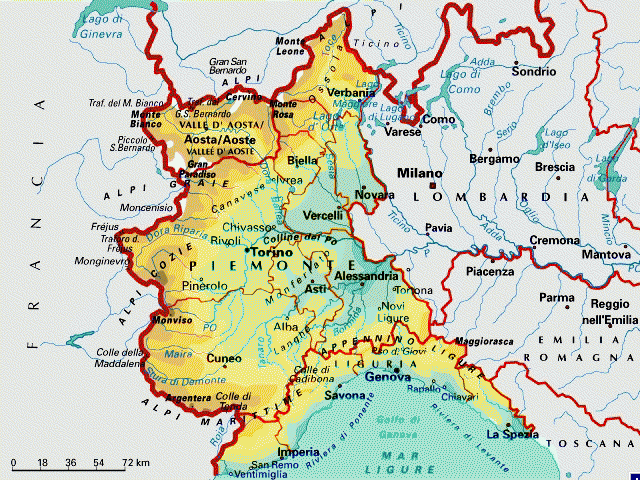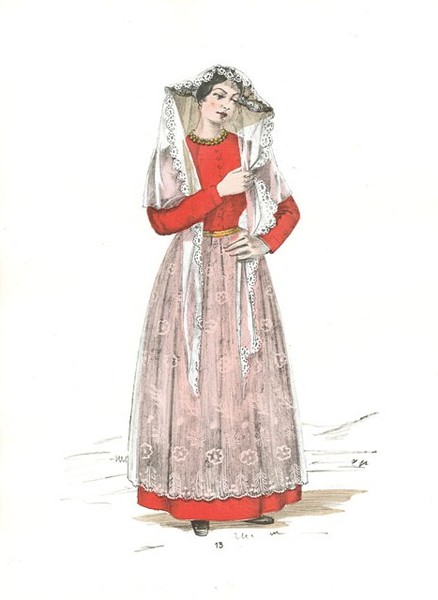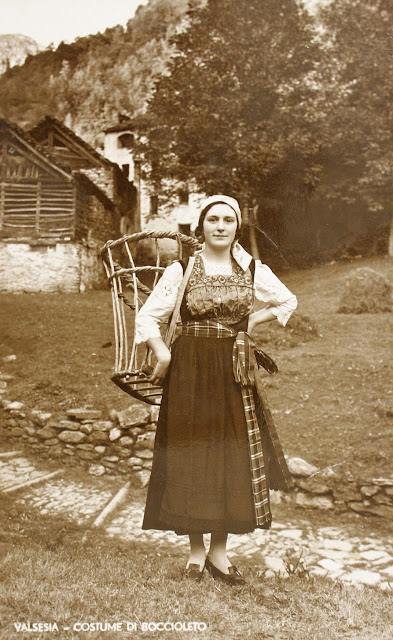Hello all,
Today I will continue my overview of the Paese of Piemonte. I will cover the provinces of Vercelli, and Biella. The traditional language of Biella and Vercelli is Piemontese, Some of the villages speak Walser German, being linguistic islands. Here are our two maps again. Biella, the north half of Vercelli, called Valsesia is mountainous, and the southern half of Vercelli is found on the plains.
Biella
https://en.wikipedia.org/wiki/Province_of_Biella
Biella is a small province southeast of Aosta. The traditional language is Piemontese. I have found little from this province.
The first is the only image I have found of a festive outfit. The rest are all working clothes.
Vercelli
https://en.wikipedia.org/wiki/Province_of_Vercelli
The Province of Vercelli is shaped rather like an asymmetrical dumbell. It lies north, east, and south of Biella. The southern part lies in the Po valley, and is flat, highly populated, and well integrated into the history of Fashion. The neck and northern part consist of the Valley of the Sesia. There are many well preserved costumes in these mountain valleys, as well as a unique type of lace called puncetto. A couple of the villages in the mountains are Walser German.
Vercelli City
https://en.wikipedia.org/wiki/Vercelli
There is a plate by Calderini which shows a bride from Vercelli.
I have found only a couple other images, and they seem to be copies of this one by different artists.
Valsesia.
https://en.wikipedia.org/wiki/Valsesia
The north half of the province consists of the Sesia River valley and tributaties. I will devide this into four zones in order to somewhat organize the material. This image from the 1930 wedding of Prince Umberto shows a few different costumes from this area.
As does this more recent photo.
Bassa Valsesia - Lower Sesia Valley
This is the narrow and relatively low lying part of the valley which lies downstream of the major tributaries, from Grigniasco up to Varallo. The costumes here look more like lowlander outfits. I will work my way upstream.
Grignasco

Video of performing group of this town
https://www.youtube.com/watch?v=49yR8zRh-Zg
Parasol dance of Borgosesia.
https://www.youtube.com/watch?v=rCj4i2WQzc8
This town lies in the hills to the east.
Quarona
Morondo
Roccapietra
Civiasco
This town lies in a small side valley to the east.
This town lies in another small left bank side valley.
Cervarolo
This lies in the same minor side valley as Camasco.
Varallo
This town lies in the main valley just south of the first major tributary valley.
Procession of the 'Seven Marys' on Palm Sunday
Val Mastallone
This is the first of the three major valleys at the head of Valsesia. I have already done an in depth analysis of the major costume of this valley. https://folkcostume.blogspot.com/2014/12/costume-and-embroidery-of-fobello-and.html The various villages of this valley from Sabbia up to Fobello wear essentially the same costume. That of Rimella is somewhat different, owing to it being located in a side valley and being inhabited by Walser Germans instead of Piemontese Italians.The costume includes a very particular kind of openwork called puncetto, worked by tying knots with a needle. Work in white or yellow is done on the chemise, and colored work is done on the apron, which is worn folded up.
Sabbia
Cravagliana
Cervatto
Fobello
Rimella
Called Remmalju in Walser German, this town has a distinct costume, and is inhabited by Walser. One distinction is that they wear the apron around the waist, in contrast to the rest of the valley.The also wear an embroidered stomacher with the bodice.
Val Sermenza
This is the second valley, going east to west. I will proceed up the valley. The costume here is similar to that of Val Mastallone, but recognizably different. The apron is also worn folded up, but with little to no ornament.
Rossa
This is called Rosa on some maps. It is near the mouth of the valley and the women here do not fold their aprons up.
Boccioletto
Fervento
Rimasco
Carcoforo
This town lies in the north or right branch when facing upstream.
Rima San Giuseppe
Called Arimmu o Ind Rimmu by the Walser that inhabit the village. This is the highest village in the left fork.
Alta Val Sesia
Also called la Valle Grande. The third main valley is the continuation of the main Sesia river valley, from Vocca, which actually lies between the two other valleys, up to Alagna Valsesia, another Walser enclave at the head of the valley. The Walser tend to live in the highest villages in these valleys, because they migrated from the north over the mountains from Canton Valais -Wallis in Switzerland.
This image shows various costumes from this valley.
Vocca
Scopa
Scopello
Campertogno
Alagna Valsesia
https://en.wikipedia.org/wiki/Alagna_Valsesia
In Walser German Im Land. This town was founded by Walser in the 13th cent. Some of the inhabitants still speak the Walser dialect. Alagna lies at the foot of Mt. Rosa, the second highest peak in Europe.
Every year in Varallo, they hold a festival of the folklore of this area. Here is a video that shows part of what happens. You should be able to place most of these costumes at this point.
https://www.youtube.com/watch?v=5FPNmiLKsko
A video about a cultural gathering of Valsesia.
https://www.youtube.com/watch?v=Ke-V6q7F9AE
Thank you for reading, I hope that you have found this to be interesting and informative.
Roman K
email: rkozakand@aol.com












































































































































Se posso aggiungere un consiglio: dato che parti da fonti storiche e testi antichi, potrebbe essere utile fare un controllo del plagio plagiotesi.com per verificare l’originalità del contenuto e assicurarti che tutto sia correttamente citato.
ReplyDelete